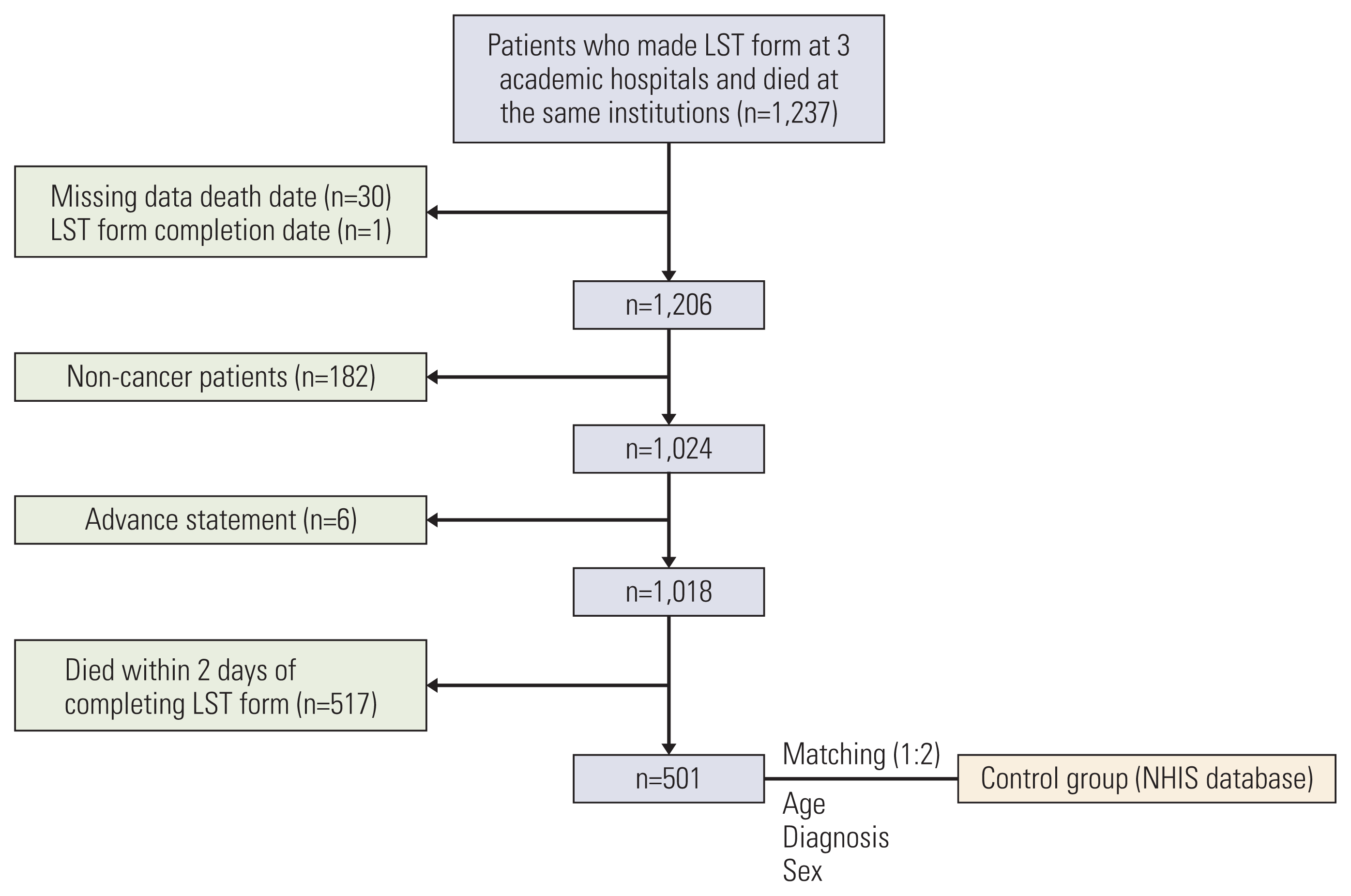1. Earle CC, Landrum MB, Souza JM, Neville BA, Weeks JC, Ayanian JZ. Aggressiveness of cancer care near the end of life: is it a quality-of-care issue? J Clin Oncol. 2008; 26:3860–6.

2. Ho TH, Barbera L, Saskin R, Lu H, Neville BA, Earle CC. Trends in the aggressiveness of end-of-life cancer care in the universal health care system of Ontario, Canada. J Clin Oncol. 2011; 29:1587–91.

3. Keam B, Oh DY, Lee SH, Kim DW, Kim MR, Im SA, et al. Aggressiveness of cancer-care near the end-of-life in Korea. Jpn J Clin Oncol. 2008; 38:381–6.

4. Kim DY, Lee MH, Lee SY, Yang BR, Kim HA. Survival rates following medical intensive care unit admission from 2003 to 2013: an observational study based on a representative population-based sample cohort of Korean patients. Medicine (Baltimore). 2019; 98:e17090.
5. Tang ST, Liu TW, Wen FH, Hsu C, Chang YH, Chang CS, et al. A decade of changes in preferences for life-sustaining treatments among terminally ill patients with cancer. J Natl Compr Canc Netw. 2015; 13:1510–8.

6. Chung RY, Wong EL, Kiang N, Chau PY, Lau JYC, Wong SY, et al. Knowledge, attitudes, and preferences of advance decisions, end-of-life care, and place of care and death in Hong Kong: a population-based telephone survey of 1067 adults. J Am Med Dir Assoc. 2017; 18:367.
8. Kelley K. The Patient Self-Determination Act: a matter of life and death. Physician Assist. 1995; 19:4953–6. 59–60.
9. Kim JS, Yoo SH, Choi W, Kim Y, Hong J, Kim MS, et al. Implication of the Life-Sustaining Treatment Decisions Act on End-of-Life Care for Korean Terminal Patients. Cancer Res Treat. 2020; 52:917–24.

10. Park SY, Lee B, Seon JY, Oh IH. A national study of life-sustaining treatments in South Korea: what factors affect decision-making? Cancer Res Treat. 2021; 53:593–600.

11. Kim DY, Lee KE, Nam EM, Lee HR, Lee KW, Kim JH, et al. Do-not-resuscitate orders for terminal patients with cancer in teaching hospitals of Korea. J Palliat Med. 2007; 10:1153–8.

12. Oh DY, Kim JH, Kim DW, Im SA, Kim TY, Heo DS, et al. CPR or DNR? End-of-life decision in Korean cancer patients: a single center’s experience. Support Care Cancer. 2006; 14:103–8.

13. McCloskey EL. The Patient Self-Determination Act. Kennedy Inst Ethics J. 1991; 1:163–9.

14. Hickman SE, Keevern E, Hammes BJ. Use of the physician orders for life-sustaining treatment program in the clinical setting: a systematic review of the literature. J Am Geriatr Soc. 2015; 63:341–50.

15. Kai J, Beavan J, Faull C. Challenges of mediated communication, disclosure and patient autonomy in cross-cultural cancer care. Br J Cancer. 2011; 105:918–24.

16. Tanaka M, Kodama S, Lee I, Huxtable R, Chung Y. Forgoing life-sustaining treatment - a comparative analysis of regulations in Japan, Korea, Taiwan, and England. BMC Med Ethics. 2020; 21:99.

17. Shao YY, Hsiue EH, Hsu CH, Yao CA, Chen HM, Lai MS, et al. National policies fostering hospice care increased hospice utilization and reduced the invasiveness of end-of-life care for Cancer patients. Oncologist. 2017; 22:843–9.

19. Lee SM, Kim SJ, Choi YS, Heo DS, Baik S, Choi BM, et al. Consensus guidelines for the definition of the end stage of disease and last days of life and criteria for medical judgment. J Korean Med Assoc. 2018; 61:509–21.

20. Zive DM, Fromme EK, Schmidt TA, Cook JN, Tolle SW. Timing of POLST form completion by cause of death. J Pain Symptom Manage. 2015; 50:650–8.

21. Mo HN, Shin DW, Woo JH, Choi JY, Kang J, Baik YJ, et al. Is patient autonomy a critical determinant of quality of life in Korea? End-of-life decision making from the perspective of the patient. Palliat Med. 2012; 26:222–31.

22. Kim JW, Choi JY, Jang WJ, Choi YJ, Choi YS, Shin SW, et al. Completion rate of physician orders for life-sustaining treatment for patients with metastatic or recurrent cancer: a preliminary, cross-sectional study. BMC Palliat Care. 2019; 18:84.

23. Sabatino CP. The evolution of health care advance planning law and policy. Milbank Q. 2010; 88:211–39.

24. Yoo SH, Choi W, Kim Y, Kim MS, Park HY, Keam B, et al. Difficulties doctors experience during life-sustaining treatment discussion after enactment of the Life-Sustaining Treatment Decisions Act: a cross-sectional study. Cancer Res Treat. 2021; 53:584–92.

25. Kwon JH, Kim DK, Shin SJ, Park JY, Lee HJ. Analysis for current status of end of life (EoL) care decision and exploration of Korean shared decision making model. Seoul: National Evidence-based Healthcare Collaborating Agency;2020.




 PDF
PDF Citation
Citation Print
Print



 XML Download
XML Download